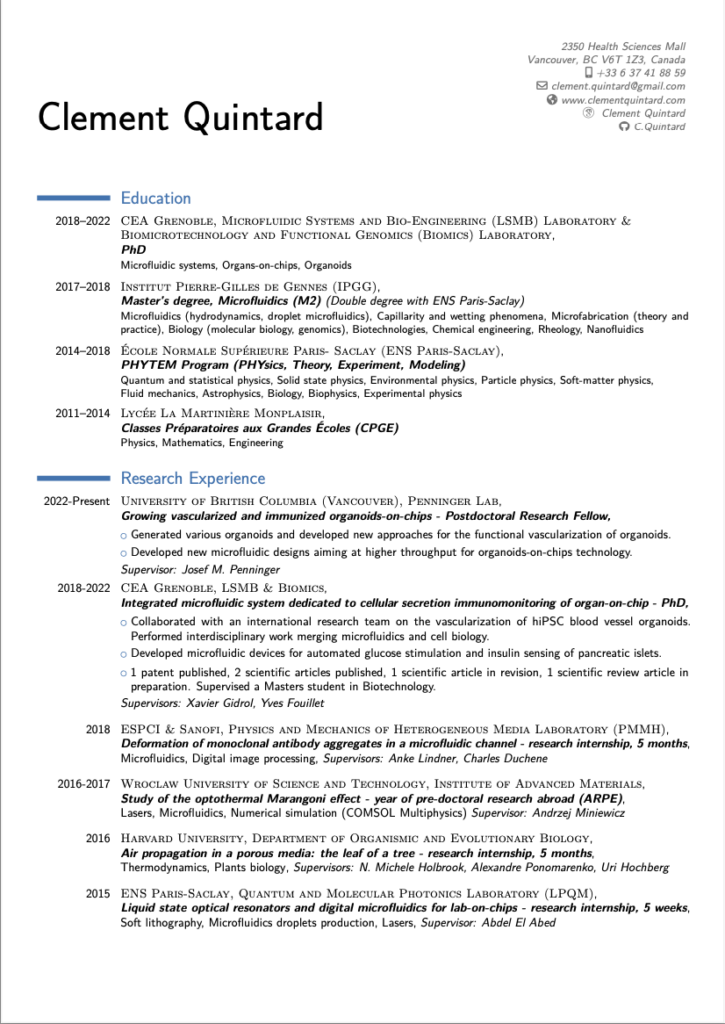Resume
Research
Research Overview – Postdoctoral Research
I am a Postdoctoral Fellow in the Lab of Josef Penninger at University of British Columbia, Vancouver, Canada. My research sits at the interface of stem cell biology, organoid engineering, and microfluidics, with a focus on developing functionally vascularized and immunized organoids-on-chip. During my postdoc, I am pushing the field forward by:
- Enhancing microfluidic platforms to improve throughput and scalability.
- Developing fully stem cell-derived models for greater physiological relevance.
- Incorporating immune components to mimic immune cell trafficking and interactions in microphysiological systems.
- Innovating new vascularization strategies for organoids beyond blood vessels, including heart, pancreas, lung, brain, and cancer models.
PhD Research
Driven by my goal of combining fundamental research with translational applications, I pursued my PhD at Commissariat à l’Énergie atomique (CEA) in Grenoble — a setting that allowed me to engage in industry-collaborative projects while maintaining the scientific rigor necessary for high-impact publications.
My PhD focused on engineering vascularized organoids-on-chip by developing novel microfluidic strategies to overcome existing limitations. This work led to two first-author publications (Quintard et al. Nature Communications 2024 and Quintard et al. Biosensors and Bioelectronics 2022 ) and one patent. Of note, my PhD thesis was selected to represent my doctoral school in the Best PhD Thesis Award competition.
Beyond my primary project, my PhD was an invaluable training ground in multidisciplinary collaborations. I was involved in large-scale projects spanning diverse expertise, from academic institutions to biotech startups and industrial partners. This experience gave me insight into how complex scientific projects are conceived, led, and executed across multiple disciplines. Additionally, I worked on the standardization of microfluidic technologies, including the development of norms (e.g., Luer standards) to ensure compatibility, scalability, and ease of use. Recognizing that organs-on-chip and other microfluidic technologies will only be widely adopted by industry if they become standardized and user-friendly, I became particularly interested in bridging the gap between academic innovation and industrial implementation. As the saying goes, “Discoveries can’t change the world if they don’t leave the lab”.
Academic Background
I began my studies in mathematics, physics, and engineering through the Classes Préparatoires aux Grandes Écoles, before being admitted to the Department of Physics at École Normale Supérieure Paris-Saclay.
My academic interests ranged from quantum physics and optics to fluid mechanics and biophysics. Over time, I became particularly interested in the intersection of physics and biology, which ultimately shaped the direction of my research.
My transition into biology began during my first Master’s internship in Noel Michele Holbrook’s lab at Harvard University. The lab explored the physics of vascular transport in plants, studying how water and solute movement between soil and leaves shapes ecological and evolutionary processes. This project was pivotal for me — it was the first time I saw physics and biology deeply interconnected, and I realized the importance of integrating both perspectives when studying complex biological systems. I also gained my first experience with microfluidics, as we used controlled microfluidic systems to study embolism mechanisms in poplar and vine leaf veins during drought conditions.
Motivated by this experience, I pursued my second year of Master’s at Institut Pierre-Gilles de Gennes (IPGG) in Paris, specializing in microfluidics. It was here that I discovered organs-on-chip technology in Stéphanie Descroix’s course — a topic that fascinated me and ultimately shaped my decision to pursue a PhD in the field. The IPGG environment was exceptional — a cutting-edge institute in the heart of Paris, founded by Patrick Tabeling, a pioneer in microfluidics. The institute was a unique ecosystem where researchers, startups, and students constantly interacted, fostering both academic and industry-driven innovation.
For my Master’s thesis, I joined a collaboration between Anke Lindner’s lab and Sanofi, where I worked on the deformation of protein aggregates in microfluidic channels. This experience gave me first-hand exposure to industrial research standards, both in terms of experimental execution and project design. Compared to the more flexible and exploratory nature of academic labs, industrial research required a heightened level of precision, organization, and reproducibility — an approach that has since shaped my perspective on scientific rigor.


